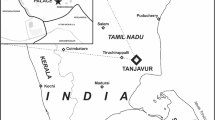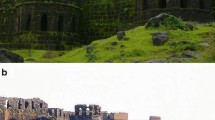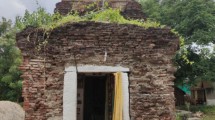Abstract
The cementing lime mortars used in the construction of twelfth century CE Gopal Krishna temple at Western India Alandi were investigated for its mineralogical, chemical and compositional characteristics. The investigative studies were performed using particle size studies, XRF, XRD, FTIR, SEM–EDX and thermal analysis of the mortar. Though the monument is situated in Sahyadri range of Deccan basaltic trap, the mortar is marked by mixing of aggregates rich in hydrated oxides of alumina and iron. Further studies revealed natural formation of laterite capping on basaltic hillock that preferentially weathered and sediments deposited along the river basin sourced as aggregates in mortar preparation. The lime rich binder has mainly inclusion of sub-angular to sub-rounded coarse grain lateritic aggregates. The clay impurities have reduced the purity of lime as observed through thermal analysis. The data will help prepare a compatible mortar for restoration.








Similar content being viewed by others
Data Availability
Not applicable.
References
Bakshi, S., & Singh, M. R. (2020). A petrochemical study of Mughal plasters of Quila-I-Ark, Aurangabad with respect to technology and repair. History of Science and Technology, 10(2), 163–184.
Burley, S. D., Gould, T., Taylor, A., & Mishra, P. (2022). Syn-rift volcanism in the Barmer Basin: An intra-basin extrusive complex at the northern limit of the Deccan Volcanic Province in India. Geological Journal. https://doi.org/10.1002/gj.4659
Dighe, B., Singh, M., & Karche, T. (2021). Traditional use of organic additives (bamboo foliage, flax fibre and millet grains) in 16th century lime plaster of Solapur Fort, India. Indian Journal of Traditional Knowledge (IJTK), 20(1), 106–116.
Dindal C. (2022). Study of natural springs (Kunda’s) at Alandi: A religious textual and scientific perspective. An unpublished MA Dissertation from Deccan College Deemed University, Pune.
Eraly, A. (2002). Gem in the lotus. Penguin.
Genestar, C., Pons, C., & Más, A. (2006). Analytical characterisation of ancient mortars from the archaeological Roman city of Pollentia (Balearic Islands, Spain). Analytica Chimica Acta, 557(1–2), 373–379.
Glushkova, I. (1997). In quest of Alandi-Mahatmya. Annal of the Bhandarkar Oriental Research Institute, 78(1), 199–213.
Gurav, M. D. (n.d.). Retrieved from https://www.lulu.com/es/shop/dr-mahadev-d-gurav/a-geographical-study-of-fairs-and-festivals-in-pune-district/paperback/product-1g28878k.html
Kant, A. P., & Singh, M. R. (2019). Spectroscopic and chromatographic investigation of the wall painted surface of an 18th century Falian Temple, New Delhi. Vibrational Spectroscopy, 104, 102947.
Kasem, M. A., Yousef, I., Alrowaili, Z. A., Zedan, M., & El-Hussein, A. (2020). Investigating Egyptian archeological bone diagenesis using ATR-FTIR microspectroscopy. Journal of Radiation Research and Applied Sciences, 13(1), 515–527.
Maniatis, Y. (2009). The emergence of ceramic technology and its evolution as revealed with the use of scientific techniques. na.
Morrison, K. D. (1995). Trade, urbanism, and agricultural expansion: Buddhist monastic institutions and the state in the early historic western Deccan. World Archaeology, 27(2), 203–221.
Naravane, M. S. (1998). The maritime and coastal forts of India. Aph Publishing.
Panda, S. S., Mahapatra, P. K., Chaturvedi, R. K., & Kar, S. K. (2013). Chemical analysis of acncient mortar from excavation sites of Kondapur, Andhra Pradesh, India to understand the technology and ingredients. Current Science, 105(6), 837–842.
Rajaguru, S. N. (1970). Studies in the late Pleistocene of the Mula–Mutha. Unpublished Ph.D. Dissertation, University of Poona.
Ray, R., Sheth, H. C., & Mallik, J. (2007). Structure and emplacement of the Nandurbar-Dhule mafic dyke swarm, Deccan traps, and the tectonomagmatic evolution of flood basalts. Bulletin of Volcanology, 69, 537–551.
Sathyabhama, B., Hema, A., Smriti, H., & Mohandas, K. P. (2011). Salvankuppam coastal temple excavation and application of soil micromorphology. Current Science, 100(7), 1071–1075.
Scheidegger, A., Borkovec, M., & Sticher, H. (1993). Coating of silica sand with goethite: Preparation and analytical identification. Geoderma, 58(1–2), 43–65.
Selvaraj, T., & Ramadoss, R. (2015). Analysis and characterization of third century ancient mortars at Subramanyaswamy temple rediscovered after the 2004 tsunami near Mamalaapuram shore. India International Journal of Conservation Science, 9(1), 25–38.
Sen, G. (2001). Generation of Deccan trap magmas. Journal of Earth System Science., 110(4), 409–431.
Sheth, H., Samant, H., Patel, V., & D’Souza, J. (2017). The volcanic geoheritage of the Elephanta caves, Deccan traps, western India. Geoheritage, 9, 359–372.
Singh, M. (1991). Analysis of Golkonda fort plaster, Ist international colloquiums on role of chemistry in archaeology (pp. 81–86). BACRI.
Singh, M. R. (2017). Dolomitic plasters in Indian monuments and its characterization. Journal of Historical Archaeology & Anthropological, 1(6), 237–241.
Singh, M. R., Ganaraj, K., & Sable, P. D. (2020). Surface mediated Ca-phosphate biomineralization and characterization of the historic lime mortar, Janjira Sea Fort, India. Journal of Cultural Heritage, 44, 110–119.
Singh, M., & Kumar, S. V. (2018). Mineralogical, chemical, and thermal characterization of historic lime plasters of thirteenth–sixteenth century Daulatabad fort, India. Studies in Conservation, 63, 482–496.
Singh, M. R., & Kumar, S. V. (2019). Architectural features and charecterisation of 16th century Indian monument Farah Bagh, Ahmed Nagar, India. International Journal of Architectural Heritage, 14, 1–14.
Singh, M., Kumar, S. V., & Waghmare, S. A. (2015). Characterization of 6–11th century AD decorative lime plasters of rock cut caves of Ellora. Construction and Building Materials, 98, 156–170.
Singh, M., Waghmare, S., & Kumar, S. V. (2014). Characterization of lime plasters used in 16th century Mughal monument. Journal of Archaeological Science, 42, 430–434.
Singh, S. K., & Singh, M. (2020). The mineralogical and physical behaviour of brick aggregates in twelth century brick-lime step-well plasters of Gabdhak-ki-baoli, New Delhi. Journal of Architectural Conservation, 26(2), 184–200.
Steffen, T. T., Fontana, L. C., Hammer, P., & Becker, D. (2019). Carbon nanotube plasma functionalization: The role of carbon nanotube/maleic anhydride solid premix. Applied Surface Science, 491, 405–410.
Sukheswala, R. N., & Poldervaart, A. (1958). Deccan basalts of the Bombay area, India. Geological Society of America Bulletin, 69(12), 1473–1494.
Wescoat, J. L., Jr. (2019). Human use of landforms on the Deccan Volcanic Plateau: Formation of a geocultural region. Geomorphology, 331, 175–190.
Yan, W., Liu, D., Tan, D., Yuan, P., & Chen, M. (2012). FTIR spectroscopy study of the structure changes of palygorskite under heating. Spectrochimica Acta Part A: Molecular and Biomolecular Spectroscopy, 97, 1052–1057.
Author information
Authors and Affiliations
Corresponding author
Rights and permissions
Springer Nature or its licensor (e.g. a society or other partner) holds exclusive rights to this article under a publishing agreement with the author(s) or other rightsholder(s); author self-archiving of the accepted manuscript version of this article is solely governed by the terms of such publishing agreement and applicable law.
About this article
Cite this article
Singh, S., Singh, M. & Sabale, P.D. Composition and characterisation of ancient lime mortar of Gopal Krishna temple, Alandi, India. Indian J Hist. Sci. 58, 271–282 (2023). https://doi.org/10.1007/s43539-023-00103-2
Received:
Accepted:
Published:
Issue Date:
DOI: https://doi.org/10.1007/s43539-023-00103-2




